Marking Your Territory
Teaching basic building skills in an OpenSim is fairly straight forward, I have found the kids take to it fairly fast but few think through a quality build first time. Pride in workmanship comes after mastery of the tools I am hoping.
The activity was simple and open-ended – on a designated section of the continent make a slab 10m x 10m x 20cm, nestle it into the ground slightly to become your building “plot”.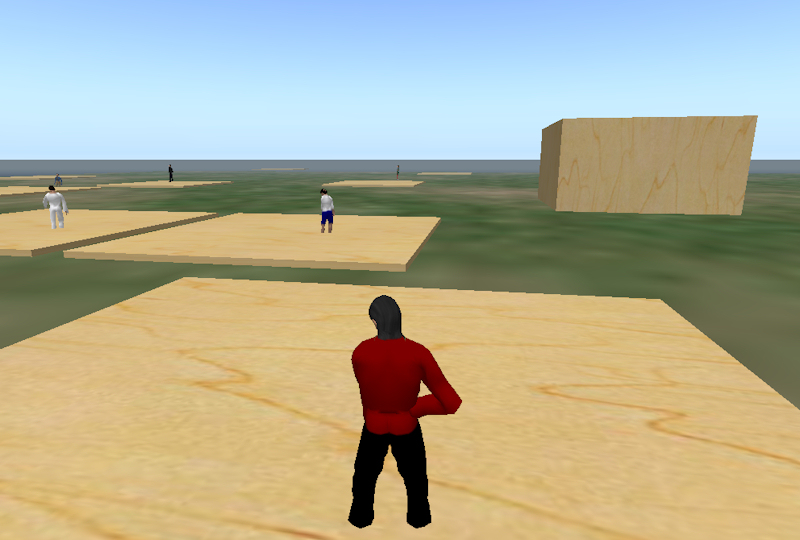
Object creation, scaling and movement skills followed texturing, exploration of other object properties and then a simple brief: make something that looks like something. the only caveat was that it needed to be on their plot, and to scale.
They took to the task with great enthusiasm, exploring the way you construct more complex things from primitives, scaling, rotating, moving with greater and greater precision that comes with experience.
In the end they were inviting their iMates over to have a look, all fairly hoopy. We have, in the next journey into this world, to tie this world activity to the activity happening in MUD and MOO and then look objectively at the whole “amount of activity required to create a unit of believable detail”, but for now, play is a good thing.
I, Avatar
We are exploring virtual words with my year 9 students and it is a rich and varied experience, well, that is the plan at least. The worlds are textiverse (a custom MUD for them to edit), a browserverse (terraMOO, a hybrid world) and an Opensim (full 3d world called terraceLIFE).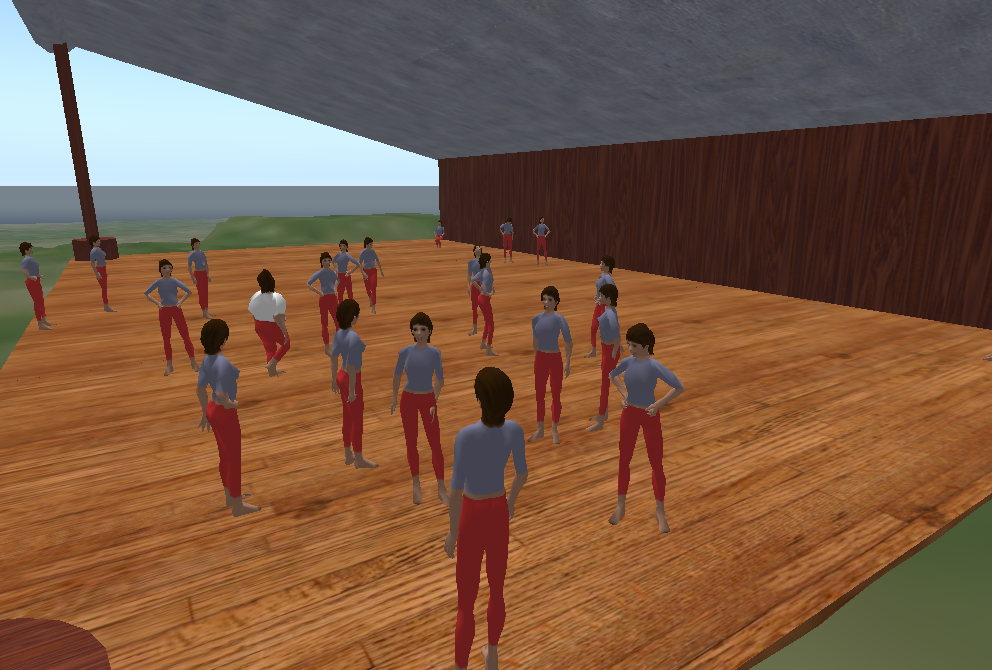
Today we ventured into terraceLIFE and explored the notion of “avatar” – the brief for the first half of the lesson was simple enough – get your avatar to look like you.
What could possibly go wrong? Year 9 boys, in an opensim, where the default avatar is RUTH, a buxom female.![]()
After some initial explanation, they took to creating a virtual presence fairly well – it is interesting to talk to them about how they see themselves – shorter than they really are, heavier than they really are, bigger nose etc. I guess it is a tall ask to do body-image stuff with year 9 boys, given the hormone storm they are currently weathering but, you know, they handled it pretty well.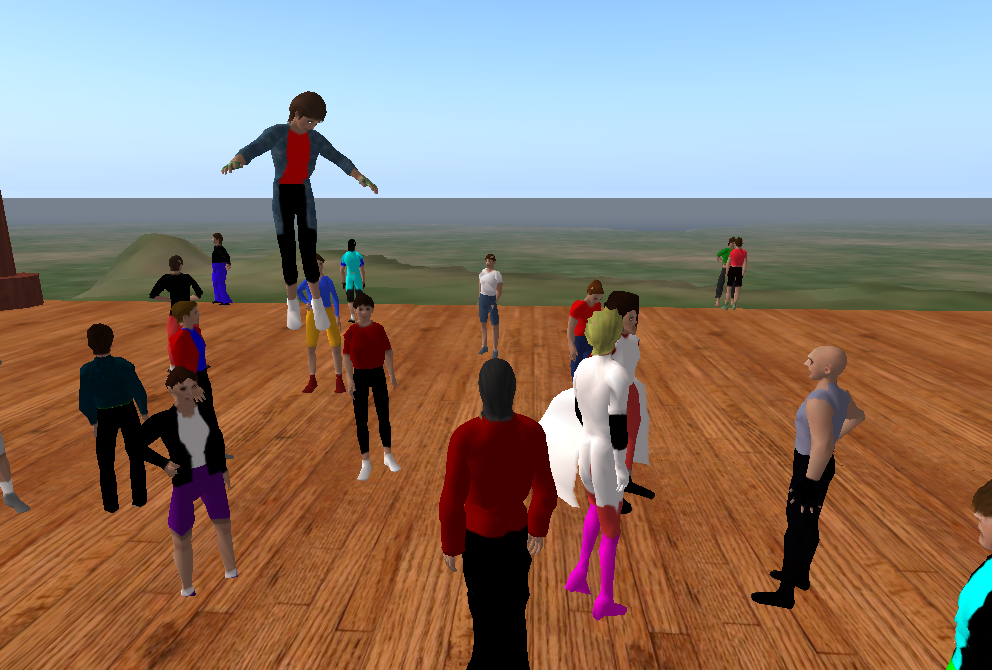
Very happy with the performance of the opensim also – 30 kids at once, all doing wonderfully interesting things, worked a charm. Next session we will explore building techniques with a simple construction project, then we will get complex and go for a collaborative building project (there will be tears before bedtime there I suspect).
I have a chunk of terrain for them to play on, will let them mark their territory and see how it goes – the only real rule here is “don’t be a dick” – it will be interesting to see how they cope.
Story Tainting
My year 9 ICTE students have begun exploring the “Virtual Worlds” unit and we are set for some good (geeky) times as they will use a Textiverse (ICTEMMO), a Browserverse (terraMOO) and a 3D Opensim (terraceLIFE) to express non-linear narrative.
The focus of this unit is storytelling, actually – the worlds merely the delivery vehicle (but don’t tell the kids, right), although each pre-suppose very different skills, offer vastly different perceptions and appeal to different levels of geek.
I tried something (they were keen and had NO IDEA what I had planned for them – that sort of “on edge excitement” is useful sometimes) involving story tree generations.
I wrote a program to randomly pick people and set about dividing the class into random pairs (under the guise of “people have to form productive partnerships, regardless of whether they would choose to” or some such tripe) and then tainted their story – let me explain:
We fired up Inspiration (a mind-mapping software title, insert your fav, it does not matter – one pooter per pair), I got them to type a story seed as their first bubble: either
- “Timmy fell down the well” for one class or
- “You regain consciousness as the airlock hisses closed behind you and the oxygen levels return to normal” for the other.
I then preceded to explain how to spread the bubble map based on possible scenarios and decisions-different outcomes, spinning stereotype story arcs just to illustrate how a story tree might work. I then deleted all but the “seed”, left that on screen while the groups then spun their stories.
I apologised profusely for tainting their story, by exploring aspects of the narrative live in front of them. I begged them to think how the story would go from their own imagination, pleaded for them to think originally, then let them at it.
The instructions were clear – make it interesting, make it make sense, talk, confer – VERY quietly so as to not influence the group beside you … go!
After 15-20 of the most interesting minutes in class this week (wow were they absorbed) they were required to upload their story trees to Moodle (so they sort of “commit” to their work) and then we looked at structure/content.
Interesting how many of them took the seed as a “starting point” for their story (neither of which make particularly good opening scenarios, unless in flashback). “Delete everything that is not original” I said – I don’t want to read someone elses story, just what YOU have come up with … not a lot left. Well, not entirely true, some argued passionately the fact that they had re-worked the story from Halo, or LOTR or whatever so that made it original, some actually did use their own imaginations but most lost lots of their trees.
So what?
Original story telling is HARD, because there has been so much story telling in the past. It is a tall ask, cold, to try and invent a good, coherent, engaging story without plunging into stereotype and popularist tripe – doubly so when readers can choose their own pathway through it (I love non-linear narrative for this very reason – no 2 readers get the same experience).
Students suggested (spontaneously) that a plan of attack would have been much better than merely launching into the narrative – give those kids a prize as they worked out, for themselves, the purpose of the lesson.
Building is the Pits
Trying to scoffold an activity so it fits into a short term means that certain details must be surfaced, processes prepared and scaffolds erected. The “builders academy” is a summary of the tutorial zone on planet Obscura and focusses on skills particular to this building task: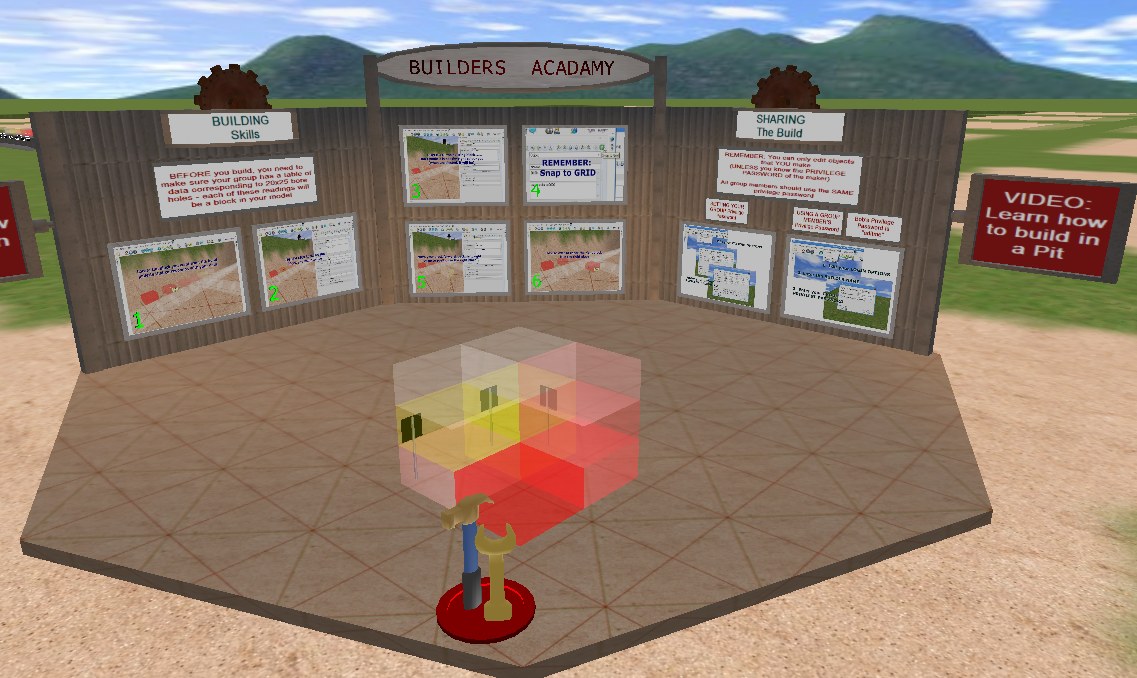
I made a machinema demonstrating techniques, and talking them through more regular tidy building practises, in the hope that if they do not want to read the worded instructions, they might take notice of a human voice modelling what they have to do. I am getting quite good at “multi-modal” explanations, and this is something that Virtual Worlds are particularly good for.
The idea is that cybernauts model, in 3D the readings they have taken in the field. The modelling then creates a 3D representation of the ore body in situ so they can then decide, based on researched costs and benefits, the most appropriate way to extract the ore.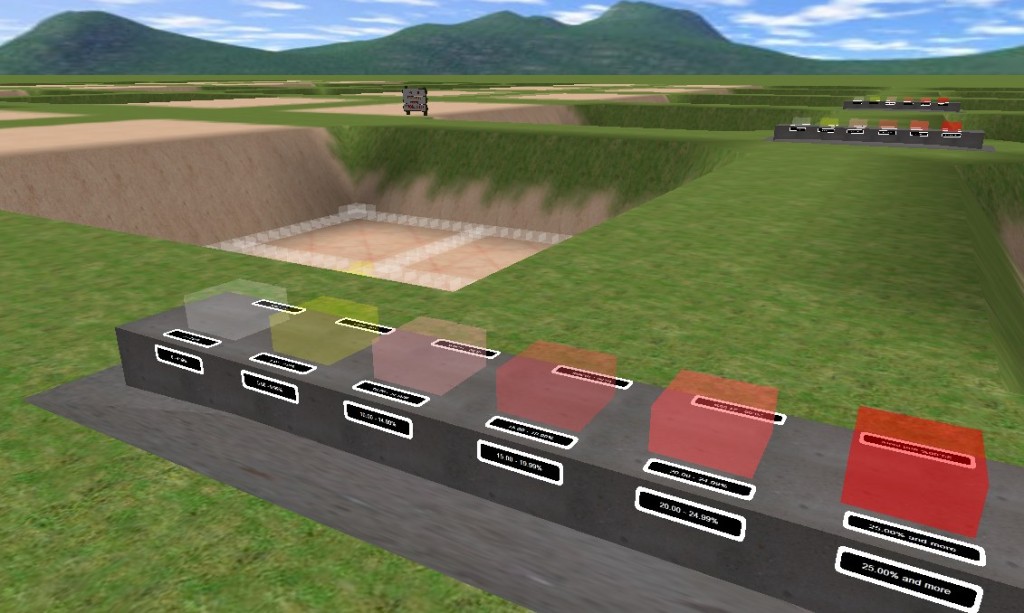 We present them with a “builders pallette” of the objects they need to complete the build – in this instance they are semi-transparent blocks that stack neatly, each representing different mineralisation readings. You can also see in the pit there is a starter grid, centred on the ore body, so they can start building from there without having to worry about aligning, scale and have an idea of extent and scope. Each pit has a “spoils” area to one side, so that later when they are demonstrating the mining technique they have selected, tehr eis somewhere to put their mined waste – again a nice demonstration of the fact that the stuff you dig up and discard has to go somewhere.
We present them with a “builders pallette” of the objects they need to complete the build – in this instance they are semi-transparent blocks that stack neatly, each representing different mineralisation readings. You can also see in the pit there is a starter grid, centred on the ore body, so they can start building from there without having to worry about aligning, scale and have an idea of extent and scope. Each pit has a “spoils” area to one side, so that later when they are demonstrating the mining technique they have selected, tehr eis somewhere to put their mined waste – again a nice demonstration of the fact that the stuff you dig up and discard has to go somewhere.
Most 3D worlds have limits, Activeworlds more than most in some regards, but I learned some valuable lessons in highly intensive, densely packed object arrays by trying to complete the activity we are asking the cybernauts to do, myself.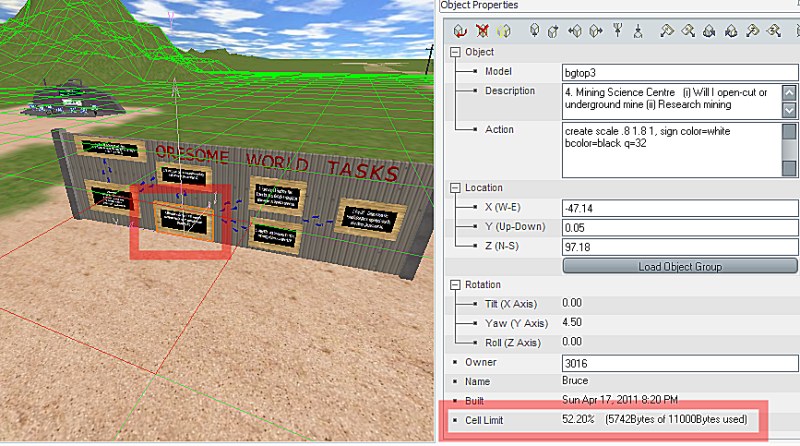
There is this thing called a “cell limit”, it is a PHYSICAL MEMORY limit the world, and I am guessing the rendering engine have whereby the total assets for a grid cell are limited. Each object instance, the NAME of the object, any ACTION scripting applied and any DESCRIPTION add to the storage requirements for that object. In the above screenshot you can see a rather sparse area of the world and a highlighted object alerts us to the fact that we have consumed 52% of the cell limit in that cell (you can see the cell grid in green and the current cell in red). This large cell usage can be explained when you realise there are 135 objects in that cell, most with HUGE names, most with create scripts etc.
This became a critical problem when I was testing the pit construction. Originally I had the blocks with lovely long names, and create scripts and a lovely long description in each – this meant that when I was 2/3 of the way through the building of my model, the WORLD prevented me from building any more in that cell … oops.
The solution was a re-making of ALL blocks (I changed the actual objects to be coloured and transparent in my 3D modelling program rather than do it with scripts in-world), gave them all tiny names (m1 .. m7) and pruned their descriptions down. the upshot of this is that I realise the object catalog that exists currently contains some obscenely wasteful object data – sure the names are descriptive but …
I like it that I am still learning in this project.
Mineral Exploration
Cybernauts explore a mineral deposit via aerial survey, surface sample, and core samples, collecting data and observations, they need somewhere to research and conextualise these: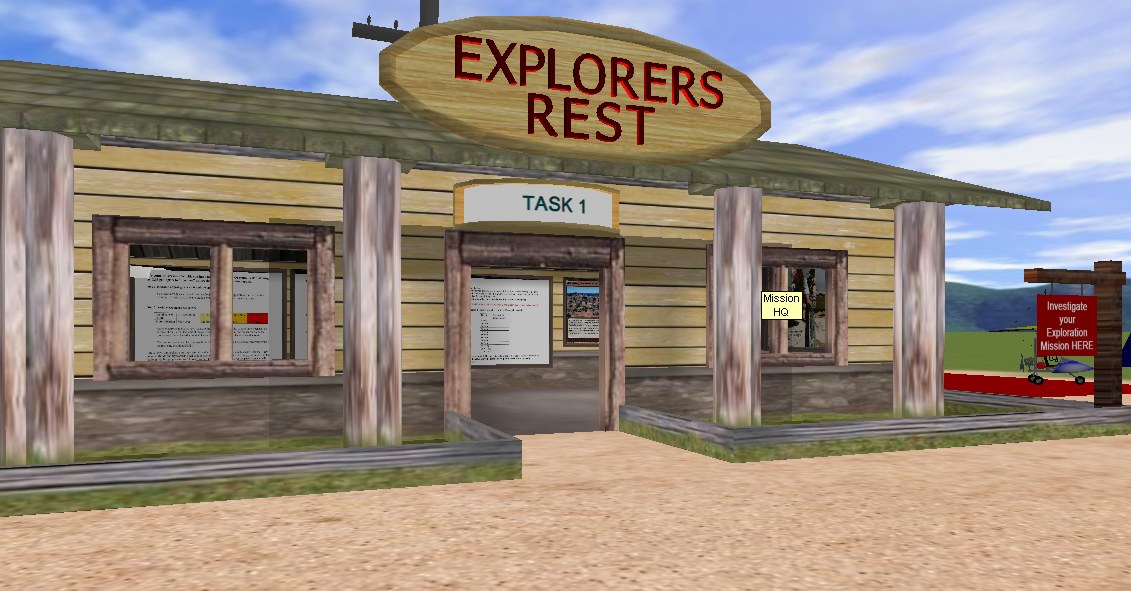
Interactives and static displays of rock types, classification, geological processes and explicit references to activities they must perform provide some nifty scaffolding for the task.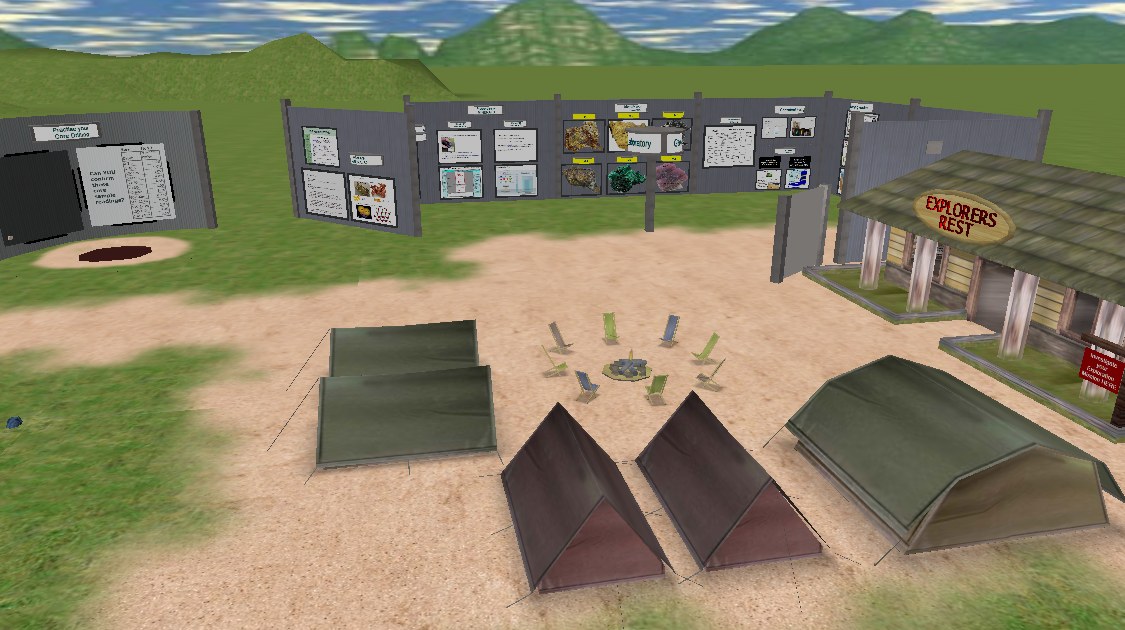
I went for a camp – feel, to give cybernauts an appreciation for the fact that often fieldwork requires this. Included is a camp-fire talk circle where they can meet privately in groups, sample tasks and a video tut on how to perform key actions – think it makes sense – we shall soon see.
